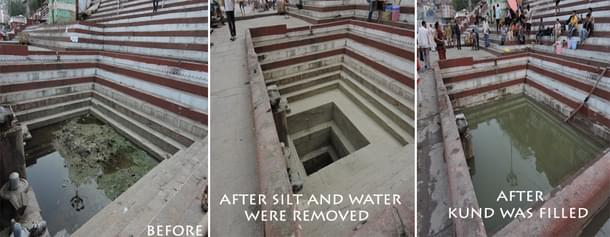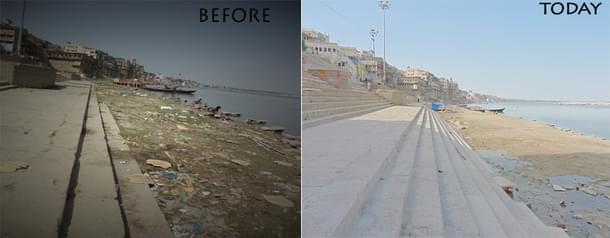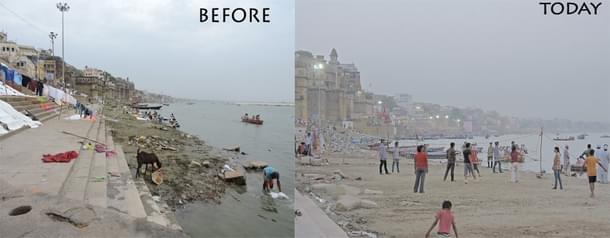Ideas
Varanasi’s Journey As The Cleanest Ganga Town As Narrated By Cleanup Warrior Temsutula Imsong
Harsha Bhat
Nov 29, 2021, 03:43 PM | Updated 07:20 PM IST
Save & read from anywhere!
Bookmark stories for easy access on any device or the Swarajya app.
In 2012, it was her first trip to the town of Kashi and the ghats of Ganga. In 2021, it is her daughter’s first trip to the same place, same river. But that’s where the similarity ends.
For almost everything that Temsutula Imsong witnessed when she first met ‘Gangaji’ has changed and in less than a decade, she is back to where she began, this time with her daughter Prangshi, who has inherited an experience that is in total contrast with that of her mother’s.
While Imsong had dung, debris, defecation, dirt and decades of dumped garbage and stench greeting her, little Prangshi, along with lakhs of visitors who descended on this ancient town this Dev Deepavali had clean, beautiful, decorated ghats, and a pristine, mighty river Ganga on whose lap she enjoyed a boat ride feeding the storks.
But the image of the mother-daughter duo is the story of transformation and how the will to make change happen has actually ensured the next generation inherits a better world — and all in less than a decade.
And #Prangshi gets to meet #Gangaji at #Kashi .. after waiting for 2 years .. pic.twitter.com/OFxCXMRgoY
— Temsutula Imsong !!शà¥à¤ दà¥à¤ªà¤¾à¤µà¤²à¥!! (@temsutulaimsong) November 15, 2021
Here are excerpts from a conversation with Imsong, as Kashi for the second consecutive year is ranked the best Ganga town in the country for excellent work in cleanliness at the ghats and along the river in the temple city and its surroundings in the annual cleanliness survey of the Union Ministry of Urban and Housing Development.

The difference is for all to see, she says. “If I go down memory lane back to 2012-13, the difference is as stark as black and white. Gangaji was still her mighty powerful self but garbage was floating all around, there was no ghat walk possible, foul smell emanated from every single corner,” she explains as she recollects her journey with ‘Gangaji’ and her cleanup.

"I see tweets of those who are still finding some corner dirty or some dirt some dump somewhere now — but this is nothing, not even a pinpoint in comparison to what it was," says Imsong, who started with a team of volunteers cleaning the much lesser frequented Shool Tankeshwar Ghat.
As she recounts the most often asked question as to why the ghats stayed dirty for decades, pat comes her response too. “I don’t know why it was neglected — may be no one paid attention. Or may be because Varanasi didn’t get a visionary leader like Modiji — for both Kashi and Gangaji from a religious perspective have been there and important from eternity.”
Imsong’s journey and work on the Prabhu Ghat that they started in 2015 won the attention of the nation as Prime Minister Narendra Modi lauded their efforts and that alongwith the Swacch Bharat campaign motivated them to take up the cleanup of the entire stretch along Gangaji, she says.
Read about the work she undertook then here, in this article penned as she received the Swarajya Award for Social Work in 2016.
“When we started in 2015, when Modiji took the spade and got to cleaning the Assi Ghat, only four to five ghats were clean. Remaining were unimaginable — open defecation was a norm.” Cut to 2021, all this has changed, she says, adding that it is not just the cleaning but also the provision of and placement of dustbins, their regular cleaning and the construction of toilets that has helped bring about a change.

The journey has been one huge leap of faith. For it has not just meant getting hands-on and cleaning the ghats and the river banks, but also making space for hygiene and sanitation and a sense of ownership of the ghats in the minds of people.
“When Modiji gave a call, we and so many groups came forward to undertake on ground efforts. The Kashi debates were started — after shramadaan we would conduct Kashi debates — to make people aware that we are cleaning this. And that it is not just ours — but that the ghats belong to all of us and we all should clean and maintain. That we should not dirty it because ‘Ganga ji Hamara hai’. This is how we spread awareness. So many groups, so many individuals — Swacch Bharat — so many people have strived to spread awareness,” she explains.
“A few of us were made ambassadors of the Nagar Nigam. We along with the Nagar Nigam and radio stations started talking to people and undertaking numerous workshops, songs, displays at the main chaurahas. Numerous teams were out there to engineer and enable this change in attitude and the effort is ongoing. Like you can't take the paan away, but the spitting has definitely reduced,” she adds.
But it isn’t just the organisations or the systems put in place that have brought about this change. “The entire city has been part of the effort to trigger mind change. All schools, and children and youth have joined hands — with placards and rallies — to create awareness. All Kashivasis have strived for this,” she says, claiming no credit for her efforts to spearhead a sanitation revolution.
The recently concluded Dev Deepavali grandeur is a testimony to all that has changed. As what could have been a sanitation nightmare with lakhs of people having descended on the ghats that night, with countless lamps lit all along, with pilgrims from across the country having made the ghats their home that evening, that it could look all clean and neat the following morning was unimaginable.
The contrasts with the bygone era don’t end here.
Having witnessed the grandeur of Deepotsav which also saw a laser show at the Chet Singh Ghat that has had audiences captivated for the last two years, it is unbelievable almost to hear from Imsong that this was once a spot that had not a single lamp.
“When we started then there would be no lights, it would be completely dark, especially at night — both Chet Singh Qila and Prabhu Ghat would be completely dark, but it was a very beautiful stretch of the ghat — which is why probably they now chose it for the laser show. The Chet Singh ka qila they would tell us is a haunted fort which is why the lights can't be switched on. They would tell us that ghosts will spoil the lights even if we put them on and that was why the ghats remained dark,” she says.
This is the FIRST of the TWO TWEETS .. its a request, please read both of them ... Look at this pic, its of #ChetSinghGhat earlier .. In the attached tweet you can see why it was used .. Read this too >> https://t.co/GWSuVOVZGZ ... #MissionPrabhuGhat #ModijiinKashi 1/2 https://t.co/whqhgxWwM6 pic.twitter.com/4E8ruFshS0
— Temsutula Imsong !!शà¥à¤ दà¥à¤ªà¤¾à¤µà¤²à¥!! (@temsutulaimsong) November 30, 2020
But then the team would sit and clean the ghats post sunset too and slowly an LED or two made its way to the ghats finally illuminating both the ghats, and the minds of the people who inhabited them. From there to having it all lit and illuminated and playing backdrop to a laser show is a journey through time, space and tales.
Each ghat has a tale that can make for endless anecdotes. For cleaning the Ganga, in Imsong’s words has been a life-changing journey and one that has her believing in the magic of Ganga and her powers for life.
“I just feel happy that I was there to witness this transformation. I just feel so lucky that I was there to witness the change of the river and the ghats; that I was there at the right time and I was one of them,” she says, adding that, what she has done for Ganga is just minuscule in comparison to all that Gangaji has given her in return.
“Now we don’t need to wish for anything. Because even if we wish — it simply happens. We are even scared to wish now — because things are no longer in our hands — it simply happens,” she says as she signs off.
Harsha Bhat is an author, linguist, content strategist, and a compulsive chronicler of Bharat's civilisational heartbeat.





